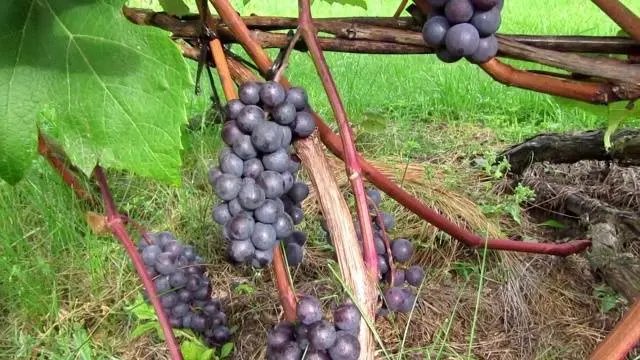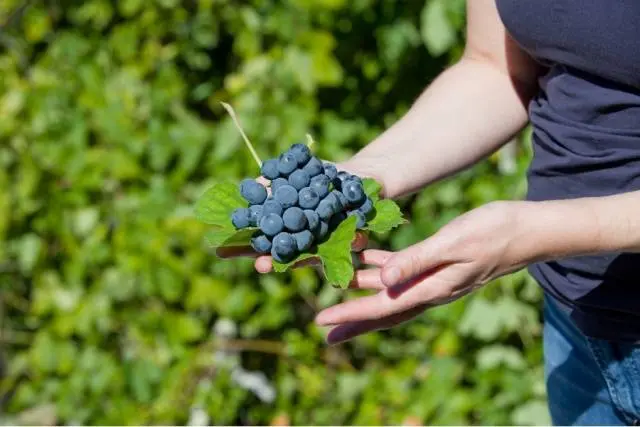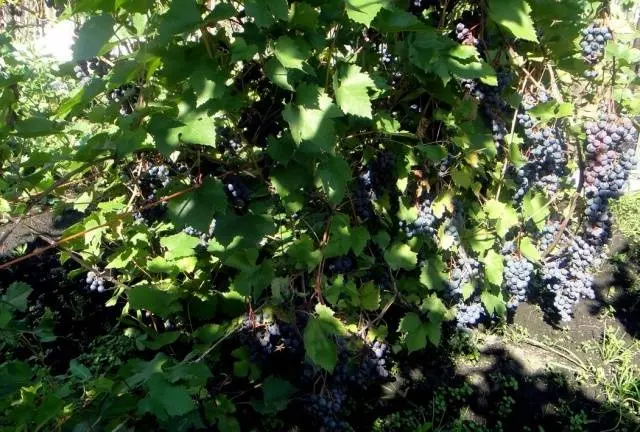Contents
There are grape varieties that delight in the size and taste of berries. Unfortunately, they can fully manifest themselves only in the south, where there is a long, warm summer. Those who live in cool regions and cannot afford to grow grapes in a greenhouse must choose from varieties that can bear fruit even with a lack of heat. One of them is the Zilga grape. It does not boast the size of bunches and berries that are characteristic of southern varieties, and its taste is quite simple, but this variety is for busy growers. Even with unobtrusive care, and the absence of shelter for the winter, he will regularly give not very large, but such desirable bunches of grapes. Zilga belongs to technical grades.
Features of technical grades
Technical grades of grapes are intended for production of wine from them. As a rule, the highest quality wine is obtained from varieties of medium and late ripening, but there are also a small number of early ripening grapes that are quite suitable for making wine. What are the characteristics of wine varieties:
- They are less whimsical to soils.
- They can forgive the grower for care mistakes without reducing the yield.
- Most of them are highly frost-resistant.
- Even in cold summer they accumulate a lot of sugars.
- They are easy to shape and easy to care for.
- After ripening, the berries hang on the bush for a long time and at the same time accumulate sugar.
- Technical varieties are easy to propagate.
- They are fast growing
- The use of berries in technical grapes is universal, and the yield is high.

Description and characteristics
The variety Zilga was created by a breeder from Latvia P. Sukatnieks back in 1964. He was engaged in breeding and obtaining varieties that can grow well and bear fruit in Latvian conditions. Zilga is the result of pollination of the Smuglyanka variety by two other grape varieties: Yubileiny Novgorod and Dvietes Zilas. In its genotype, as in some other Latvian varieties, there is the Amur grape gene, it was he who gave Zilga high frost resistance.
The variety is not included in the State Register of Breeding Achievements, but, according to gardeners, it is with him and some others that inexperienced winegrowers need to start growing this sunny berry.
Varietal features:
- Zilga is an industrial grape variety. This does not mean that it cannot be consumed raw, but most of all it is suitable for making wine.
- The ripening period of Zilga grape berries is early. The first berries can be tasted after 105 days, provided that the SAT is 2100 degrees.
- The vigor of this grape variety is high.

- The maturity of the shoots is very good – by 90%.
- Their fruitfulness is also at a decent level – from 80 to 85%.
- The vine is cut, leaving 5 to 7 eyes.
- Experienced growers for this variety recommend a multi-armed correct formation with a garter to the trellis.
- Zilga grapes are well compatible with any rootstocks.
- The Zilga variety does not require crop rationing.
- The frost resistance of the variety is at a good level – from -25 to -27 degrees, therefore, the grapes will normally overwinter if there is sufficient snow cover without shelter.
- Zilga is highly resistant to both oidium and mildium – 4 points.
- Zilga’s flower is bisexual, therefore, she does not need pollinators.
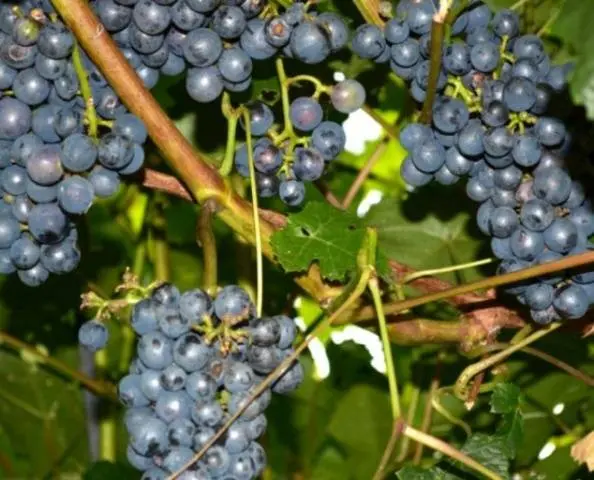
Characteristics of berries:
- The bunch is small and weighs about 90g. Its shape is cylindrical, sometimes with a wing.
- Medium-sized round blue berries, up to 2,3 g, with a pronounced prune bloom, sit rather tightly on red ridges.
- The pulp is slightly slimy, with a lot of slightly colored juice.
- In different years, Zilgi berries can accumulate from 18 to 22% sugar. Their acidity is low – up to 5 g / l.
- The tasting score of berries with a weak isabelle aroma is 7,1 points.

Wasps do not like this variety, the berries are able to hang on a bush for a long time and even sometimes raisin.
- The yield of the Zilga variety is very high. With a large formation, up to 23 kg of berries can be collected from one bush.
- The use of berries is universal: you can use them as a table and wine variety.
Planting and care
Technical varieties have their own characteristics when planting and caring.
Site Selection
Zilga grape variety does not impose special requirements on the soil. What it should be:
- The organic content is from 2 to 4%.
- The acidity of the soil is from 5,5 to 6,5.
- Light in composition sandy and sandy loamy.
- With low standing groundwater.
A place for planting Zilga grapes is chosen well-lit by the sun, closed from the cold north wind. If Zilga grapes are planted to decorate the gazebo, this should be done from the south side.
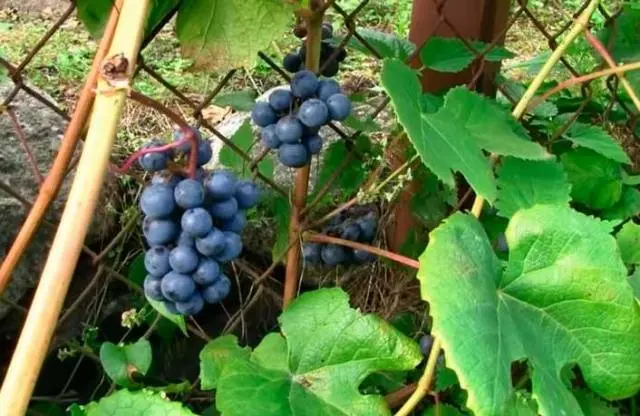
Landing
Planting seedlings can be carried out both in spring and autumn. In spring, Zilga grapes are planted after the end of spring frosts, when the soil warms up to 10 degrees Celsius. In autumn, planting dates are calculated taking into account the fact that a month without frost is needed for the rooting of grapes.
The method of planting depends on the mechanical composition of the soil. If it is heavy, it will require the formation of ridges and the improvement of the soil by adding sand. It is necessary to prepare a place for landing in advance, one season before it takes place. When planting a single bush, they dig a hole, the depth of which is 60 cm, and the width is -70 cm. If there are several bushes, they are placed in a row, the distance between them is from 1,5 to 2,5 m. Between the rows should be about 2 meters.

Landing algorithm:
- The upper part of the soil layer is mixed with rotted manure, adding about 200 g of superphosphate and the same amount of potassium chloride to each bush. Experienced winegrowers advise planting fertilizer in the lower part of the planting hole, but so that the roots do not touch them.
- A seedling is placed on a mound of the planting mixture, the roots of which are well straightened.
- Next to it, a plastic or ceramic tube is strengthened, its diameter is about 4 cm.
- Pour into a hole near a bucket of water. She must be warm.
- Cover the roots with the prepared planting mix.
- They make a roller of earth around the seedling.
- Pour another bucket of water into it.
- The seedling is cut into two buds, treating the cut with paraffin.
- Mulch the ground around the seedling with humus.

Further Care
The main operations for the care of grapes are watering, fertilizing, shaping and sheltering for the winter.
Watering
Young Zilga grape plants are watered 4 times per season:
- After removing the shelter into the installed pipe, and if it is not there, then up to 4 buckets of water mixed with 0,5 liters of ash are poured under the bush. If there is no threat of frost, the water should be warm. If it is necessary to postpone the beginning of the growing season in order to protect the plants from frost, cold water is taken.
- The second watering is carried out when the buds are formed.
- The third watering is timed to coincide with the end of flowering.

As soon as the Zilga grapes begin to acquire a color characteristic of the variety, all watering is stopped.
- The last watering is water-charging. It is carried out 7 days before it is planned to cover the plant for the winter.
For adult plants of Zilga grapes, the only watering for the season is needed – water-charging.
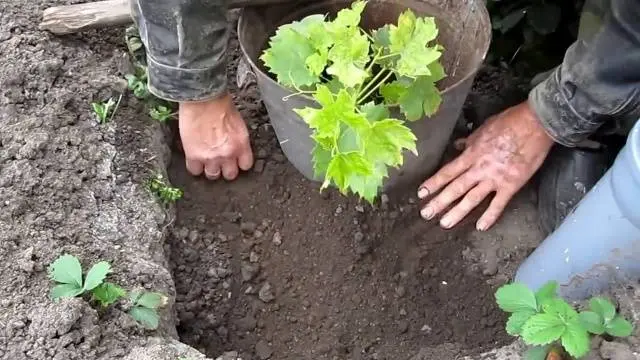
Additional fertilizing
As a rule, the fertilizers applied when planting a seedling are enough for the first three years of the growing season. In the future, both organic and mineral fertilizers will have to be applied. At the beginning of growth, the emphasis is on nitrogen fertilizing, in the middle of the growing season, universal fertilizer is needed, after the formation of berries, Zilga grapes require phosphorus and potassium, after harvesting – only potash fertilizers.
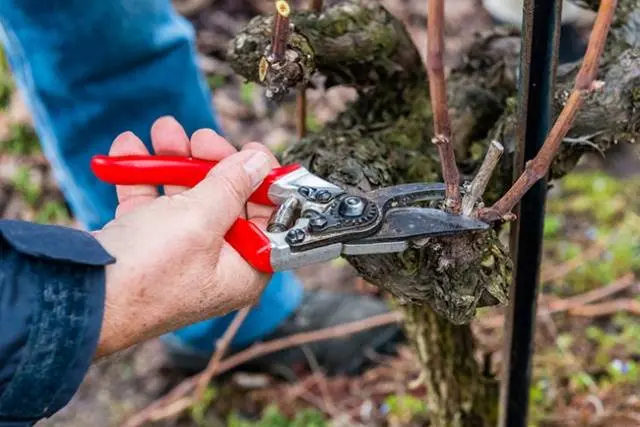
Grapes pruning
The main formative pruning is carried out in the fall. All weak and unripened shoots are cut out, the rest are shortened in accordance with the chosen formation scheme, leaving from 6 to 7 eyes.
Spring pruning is sanitary; shoots that have dried out and matured over the winter are removed. It is done before the start of sap flow, but always at a temperature not lower than plus 5 degrees.
During the summer, it will be necessary to break out excess shoots, remove stepchildren, chasing grapes, and closer to autumn, remove leaves that shade ripening clusters.
To cover or not to cover Zilga grapes for the winter? In snowless and frosty winters, it is better to play it safe and build a shelter. It is also necessary for seedlings in the year of planting. In the future, you can do without shelter.
When choosing the type of shelter, it is better to give preference to the dry-air method. Unlike shelter with earth, the eyes will not rot, and the bushes will be reliably protected from frost.
You can watch the video about the experience of growing frost-resistant grape varieties using the Chuguev method:
Reviews
Conclusion
Zilga grapes are one of the few technical varieties that can grow in most regions of our country, and in a non-covering culture. The not too outstanding taste of the berries is compensated by the high yield and unpretentiousness of the variety. It is quite worthy to be in every vineyard.










